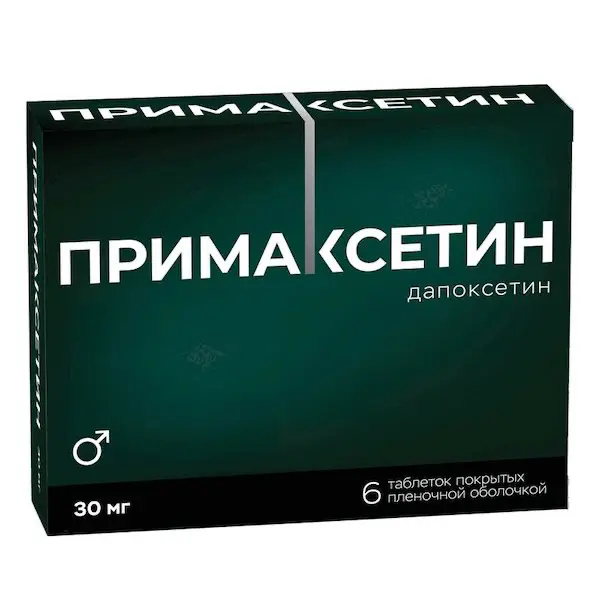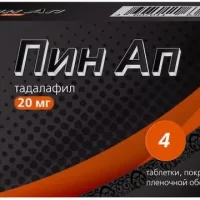Description
Primaxetine Pharmacodynamics
It is assumed that the mechanism of action of dapoxetine in premature ejaculation is associated with inhibition of serotonin reuptake by neurons with subsequent enhancement of neurotransmitter action on pre- and postsynaptic receptors.
The mechanism of ejaculation is regulated mainly by the sympathetic nervous system. Postganglionic sympathetic nerve fibers innervate the seminal vesicles, the vas deferens, the prostate, and the urethral and bladder neck muscles, causing their coordinated contraction to achieve ejaculation. Dapoxetine affects the ejaculation reflex by increasing the latent period and decreasing the duration of reflex impulse of the motoneurons of the perineal ganglia. The stimulus that triggers ejaculation is generated in the spinal reflex center, which is controlled through the brain stem by several brain nuclei, including the preoptic and paraventricular ones.
Indications
Primaxetine® is indicated for the treatment of premature ejaculation in men aged 18 to 64 years.
Contraindications
– Hypersensitivity to dapoxetine hydrochloride or any other component of the drug.
– Severe cardiac disorders (e.g., heart failure NYHA class II-IV, cardiac conduction disorders (atrioventricular conduction block of degree 2-3 or sinus weakness syndrome) in the absence of a permanent pacemaker, severe coronary heart disease or valvular lesions).
– Concomitant administration of monoamine oxidase inhibitors (MAO-I) and administration within 14 days after discontinuation. Similarly, MAO-I should not be taken within 7 days after discontinuation of Primaxetine®.
– Simultaneous administration of thioridazine and for 14 days after discontinuation. Similarly, thioridazine should not be taken within 7 days after discontinuation of Primaxetine®.
– Simultaneous use of serotonin reuptake inhibitors (selective serotonin reuptake inhibitors – SSRIs), serotonin and noradrenaline reuptake inhibitors and tricyclic antidepressants and other drugs, serotonergic drugs (e.g., L-tryptophan, triptans, tramadol, linezolid, lithium, Hypericum perforatum) and for 14 days after stopping these drugs. Similarly, these drugs should not be taken for 7 days after discontinuation of Primaxetine®.
– Simultaneous use with active CYP3A4 inhibitors, such as ketoconazole, itraconazole, ritonavir, saquinavir, telithromycin, nefazodone, nelfinavir, atazanavir, etc.
– Moderate to severe hepatic failure.
– Serious renal insufficiency.
– Age under 18 years.
– Lactase deficiency, lactose intolerance, glucose-galactose malabsorption.
Primaxetine® is contraindicated if there is a history of established or suspected orthostatic hypotension and a history of mania/hypomania or bipolar disorder.
Dosage and administration
- For oral administration. The tablet should be swallowed whole with at least one full glass of water. Primaxetine® may be taken regardless of meals.
- Do not start with a dose of 60 mg.
- In case of orthostatic hypotension in the background of taking the drug in a dose of 30 mg, it is not recommended to increase the drug dose to 60 mg.
- Adult men aged 18 to 64 years
- The recommended starting dose for all men is 30 mg, which should be taken 1 to 3 hours before the intended sexual intercourse. In case of insufficient effect and good tolerance of 30 mg dose, it may be increased to 60 mg. The maximum recommended frequency of taking the drug is once every 24 hours.
- After taking the drug for the first 4 weeks (or at least 6 doses of the drug) the doctor should carefully evaluate the “benefit-risk” ratio of its use to decide on the appropriateness of further therapy.
- Patients with renal insufficiency
- No dosage adjustment is required for patients with mild to moderate renal insufficiency, but caution is recommended. Primaxetine® is contraindicated in patients with severe renal insufficiency.
- Patients with hepatic impairment
- No dosage adjustment is required for patients with mild hepatic impairment. Primaxetine® is contraindicated in patients with moderate to severe hepatic insufficiency (classes B and C according to the Child-Pugh classification).
- Patients with low CYP2D6 activity, concomitant administration with active CYP2D6 inhibitors
- Caution should be exercised when increasing the dose of Primaxetine® to 60 mg in persons with low CYP2D6 activity or in patients taking active CYP2D6 inhibitors concomitantly with Primaxetine®.
- Patients receiving active or moderately active CYP3A4 inhibitors Simultaneous use of active CYP3A4 inhibitors is contraindicated. In concomitant use of Primaxetine® with moderately active CYP3A4 inhibitors, the drug dose should be decreased to 30 mg.
- Administration in elderly patients (aged 65 years and older)
- There are no data about safety and efficacy in this age group.
- More than 24 weeks of use
- No data about safety and efficacy beyond 24 weeks are available. If it is necessary to use the drug for a longer period of time, an evaluation of the benefit-risk ratio should be performed at least once every 6 months.



